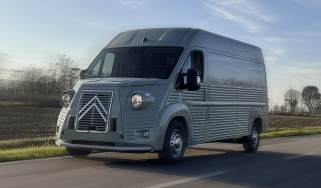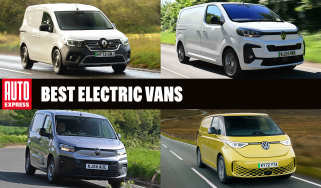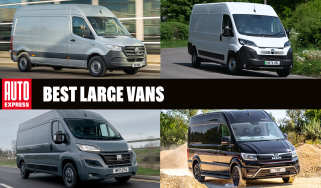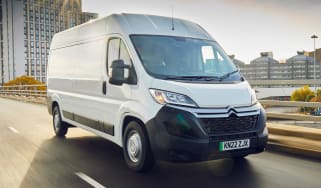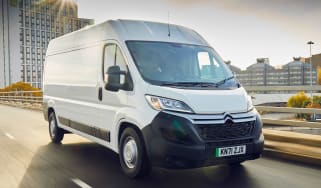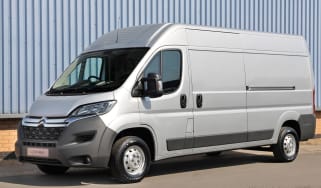Citroen Relay van review
It’s not the most advanced large van around, but the Citroen Relay gets the job done
Our opinion on the Citroen Relay
There aren’t many new van or car models on the road that can trace their roots back nearly 20 years, but the Citroen Relay is one of them. It’s the product of a philosophy that “if it ain’t broke, don’t fix it”, so the basic structure has remained unchanged over two decades, but constant development has helped it keep pace with large van rivals – just about.
The diesel models are properly old school, with plenty of noise, but good power, too, while the electric version is a bit more refined, but still a big, heavy workhorse that gives few concessions to comfort. Where the Relay excels is with the sheer variety of body styles that are on offer that mean there should be a variant on offer to suit nearly every business need, with the chassis cab version especially being well suited to customisation.
About the Citroen Relay
As with Citroen’s smaller van offerings, the Relay is one of a number of van models from Stellantis group brands that share a number of common parts. The third-generation model was originally launched in 2006, when it was also released as the Peugeot Boxer and Fiat Ducato (and called the Citroen Jumper in Europe), while in subsequent years the Vauxhall/Opel Movano, US-market Ram ProMaster and badge-engineered Toyota ProAce Max have joined the fray as badge-engineered variants of the original.
Used - available now

2024 Cupra
Formentor
38,752 milesManualPetrol1.5L
Cash £18,676
2019 Nissan
Juke
22,000 milesAutomaticPetrol1.0L
Cash £14,400
2023 Hyundai
Tucson
18,798 milesManualPetrol1.6L
Cash £18,311
2024 Hyundai
Kona
12,043 milesAutomaticPetrol1.6L
Cash £22,891Before Peugeot/Citroen and the Fiat groups merged to form Stellantis, the Relay and Boxer were differentiated from the Ducato courtesy of the different diesel and electric powertrains used by both makers. But today there is engine parity under the Stellantis umbrella, while an update at the end of 2024 saw all three models achieve equal status in terms of electric drive – before then, Fiat created the e-Ducato in-house, while Citroen/Peugeot farmed the Relay/Boxer electrification out to a third party.
As well as this update, all three large vans (plus the Vauxhall Movano) gained new front end designs to differentiate them, while the Relay benefitted from an improved touchscreen system taken from Fiat. All models in the Relay line-up come in Enterprise trim, but there are a number of options to choose from to make the van driving experience more upmarket.
There’s a starting price of around £33,000 ex.VAT for the diesel version of the Relay, although the sheer variety of body styles on offer means that what you pay will vary according to which model you choose. For starters, the panel van comes in three lengths (called L2, L3 and L4), and there are three roof heights (H1, H2 and H3), although you can’t get every roof height in every body length. At the large end of the scale you’ll also need a pre-1997 driving licence or C1 commercial vehicle permission to drive, because these versions have a gross vehicle weight of more than 3.5 tonnes.
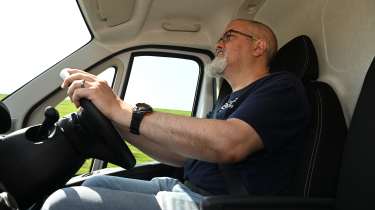
On top of this, Citroen offers a passenger-carrying Window Van (in three guises), a Chassis Cab (in five styles), a Chassis Crew Cab, Floor Cab (for Luton and low-loader bodies), plus open-bed Dropside, Dropside Crew and Tipper styles straight from the factory. On top of that, there are a number of approved converters out there that can adapt the Relay to nearly any requirement.
There are three diesel engines to choose from, all based around a 2.2-litre four-cylinder powerplant originally developed by Fiat. The base engine is a 138bhp unit with a six-speed manual gearbox, while an eight-speed automatic option is offered on selected versions. The third choice is a 178bhp version of the same unit with the eight-speed auto as standard, but this is only available in a couple of 4.25GVW rated vans. Front-wheel drive is standard
Turning to the Citroen e-Relay, this features a 110kWh battery mounted under the cargo floor, while drive comes from a 202bhp electric motor that sends power to the front wheels. The e-Relay line-up isn’t quite as comprehensive as the diesel’s, with just five panel van variants in L3H2, L3H3, L4H2 and L4H3 sizes, a single Window Van and an L3H1 Chassis Cab option. Prices start at around £51,000 for the e-Relay before any discounts are applied, and run up to £53,250 at the top of the range.
As you might expect from a work-focused van, the Citroen Relay comes in one basic trim called Enterprise, but there are plenty of options available should you wish to upgrade. Standard kit includes air conditioning, rear parking sensors, cruise control with programmable speed limiter, electrically adjustable twin door mirrors, twin rear doors and a single sliding side door. There’s a six-inch touchscreen radio with Bluetooth, a full steel bulkhead behind the cockpit and airbags for the driver and twin passenger seat.
Safety kit includes lane-keeping assist, traffic sign recognition with speed limit warning and autonomous emergency braking with pedestrian and cyclist detection.
On top of this, the e-Relay adds automatic climate control, an electric handbrake, a seven-inch infotainment screen with smartphone compatibility, plus access to Citroen’s connected services.
Available options include plastic wheel trims or alloys, body-coloured bumpers, a reversing camera, plusher fabric upholstery and technology packs that introduce a 10-inch touchscreen with increased functionality and connectivity. You can also add the e-Relay’s extra kit (climate control, electric handbrake) to the diesel version.
MPG and running costs
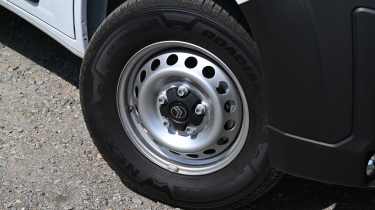
Pros |
Cons |
|
|
Prices for the Citroen Relay van start from £33,000 ex-VAT, with the Chassis Cab and Floor Cab versions starting at slightly lower prices, although you’ll need to factor the cost of conversion into those variants. All vans come in Enterprise trim, which is the only specification available - if you want to add more kit, there are options to choose from.
There’s a price walk of roughly £800 between the L2H1 van (the only panel van to come in L1 guise), then through L2H2, L3H2 and L3H3 versions. Heavy duty editions of the Relay (which feature reinforced twin-leaf rear suspension) start with an L3H2 variant at around £33,500, with the L4H2 and L4H3 versions at £800 steps above that. An auto gearbox is available with L2H2, L3H2 and L4H2 models for around £2,100 extra over the manual versions.
The electric e-Relay starts from around £51,000 before any grants are applied, which is around £17,000 more than the equivalent diesel. It’s offered in L3H2, L3H3, L4H2 and L4H3 panel van guises, plus as an L4H2 Window Van and an L3H1 Chassis Cab.
Options are plentiful, although not all of them are available on every variant. The panel van can be had with a second side door and 270-degree rear door opening, while a spare wheel is also an option rather than standard kit. A tachograph can be added to all variants, as can an upgraded seven-inch touchscreen radio.
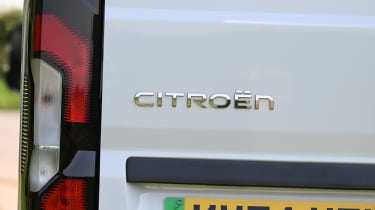
There’s a Worksite pack that adds mud & snow tyres, beefier double-leaf rear suspension, a spare wheel and wheelarch mouldings for around £750 extra, while a range of style packs can be used to upgrade the cabin upholstery and enhance the tech on board, adding kit such as alloy wheels, front & rear parking sensors, LED headlights and extra safety kit.
The Autonomous driving pack is pricey at more than £2,500, but adds a 10-inch touchscreen with boosted connectivity, upgraded cabin trim and TomTom navigation, while the Techno Pack features the same screen, and also adds a digital driver’s display, wireless smartphone connectivity and automatic climate control.
The official fuel economy figures for the diesel will vary according to body size, but the high WLTP figures range from 44-36.8mpg. The autos are at the bottom of that range, but most of the manual variants edge closer to the higher figure. A 90-litre fuel tank means more than 800 miles between fills if you can get near the higher figure. The AdBlue tank is a little on the small side at 18.6 litres – the smaller Citroen Dispatch has a 22.5-litre capacity.
Electric range, battery life and charge time
The electric e-Relay has a range of up to 263 miles, although how far it can travel will depend on how you’re driving and the payload on board. Heavy duty versions are speed limited to 56mph by law, which should help maintain range.
The battery has a capacity of 110kWh, and 97.8kWh of that is usable. Rapid DC charging at 150kW can take the battery from zero to 80 per cent charge in 55 minutes, while a standard 7.4kW single-phase charger can replenish a flat battery to full in a little under 17 hours. The CCS charging socket is located behind a flap on the lower B-pillar by the passenger-side door, in the same position as the fuel filler on the diesel.
Keep speeds low, and you should be able to manage 200 miles from a fully charged battery. There is energy recovery available, too, which is adjustable via paddles behind the steering wheel. There are three levels, with the strongest delivering a fair amount of power, although not quite enough for one-pedal driving. Using the energy recovery to slow is quite smooth, though, which will help to minimise the risk of payloads moving around under braking.
Load space and practicality
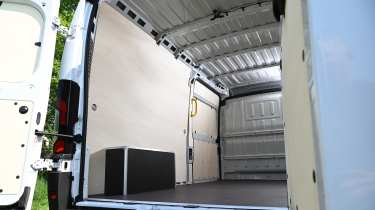
Pros |
Cons |
|
|
Where the Citroen Relay excels is with its cargo-carrying ability. With so many options offered, there should be a van to suit almost any carrying task. Cargo volumes start at 10 cubic metres for the L2H1 van, rising to 11.5 cubic metres for the L2H2, 13 cubic metres for the L3H2, 15 cubic metres for the L3H3 and L4H2, and a maximum of 17 cubic metres for the L4H3.
In comparison, a Ford Transit’s maximum cargo volume is 15.1 cubic metres, but a Mercedes Sprinter matches the Citroen at 17 cubic metres.
There are two wheelbases offered on the Relay, with the L2 measuring 3,450mm and the L3 and L4 models having 4,035mm between the front and rear axles – the rest of the L4’s length is made up by the rear overhang, for a total of 6,363mm.
The L2 is 5,413mm long, while the L3 measures in at 5,998mm. The low roof H1 body still measures in at more than two metres tall, at 2,254mm, while the H2 is 2,522mm tall and H3 is 2,760mm. Every van measures 2,050mm wide without wing mirrors, so urban width restrictions might be a bit of a challenge.
The cargo area is vast, whichever model you choose, and the electric e-Relay has the same internal dimensions as the diesel model. The H2 and H3 versions are tall enough that even six-footers can stand up straight, while the sliding side door and rear double doors open wide to ease access. The cargo floor is 535-565mm off the ground, so there is a bit of a step to get inside. There are no additional steps or grab handles to boost accessibility, although approved converters will be able to provide something useful.
There’s 1,422mm between the wheelarches and a width of 1,870mm at mid height between the walls, while the shape of the van’s bulkhead means that there’s a different length at the floor than when compared with the mid-height measurement. Floor load lengths range from 3,120mm to 4,070mm, while the length higher up is 2,914mm-3,920mm, so you’re still going to be able to get most large items in.
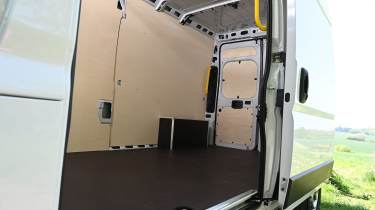
With gross vehicle weights of 3.5 and 4.25 tonnes, the Relay is able to carry some big payloads. The electric version is the poorest performer across the range in 3.5-tonne guise, because it has a payload of 710kg, but the rest of the line-up can carry well over a tonne.
You can drive 4.25 tonne GVW versions of the e-Relay on a standard post-1997 driver’s licence, and these have payloads ranging from 1,385-1,460kg - although, of course, carrying big weights will harm the van’s range.
The diesel is a real heavyweight, with payloads starting from 1,235kg and rising to a maximum of 2,030kg for the L4H2 180 Auto heavy variant. It’s worth noting that on the whole the largest vans don’t necessarily have the biggest payload capacity, though, with the next best performer in the line-up being the smallest L2H1 van, at 1,500kg.
Braked towing weights range from 2.25 tonnes to three tonnes, depending on specification, with the e-Realy having a maximum capacity of 2.4 tonnes across the board.
Reliability, safety and security
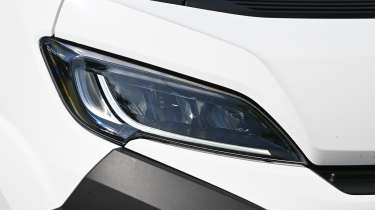
Pros |
Cons |
|
|
New vehicle legislation means that Citroen has had to equip the Relay with more safety kit than ever before. While in the past the large van sector has been left wanting for hi-tech safety kit – or even the basics such as passenger airbags – it’s a different story today.
There are three airbags up front, so the driver and two passenger seats are both catered for, while the Relay benefits from an autonomous emergency braking system with pedestrian and cyclist detection. This will be a bonus in urban driving, because while the seating position is high and has a good view of your surroundings, there are some blind spots around the van’s A-pillars, quarterlight windows and large door mirrors. The added layer of electronic safety will be useful to help mitigate the risk of collision at lower speeds. A full-height steel bulkhead keeps passengers and goods separate in the event of a forward collision – it can be deleted if you prefer.
Road sign recognition with speed limit warning is fitted to all variants, while the 4.25 tonne versions come with a limited top speed of 56mph as standard. Cruise control is also fitted, while driver fatigue tech and lane-departure warning are also included.
All of this new tech helped the Relay earn a five-star commercial van safety rating from Euro NCAP in 2025. There was a 78 per cent score for its Safe Driving tech, a 64 per cent score for the technology that’s designed to avoid crashes, and an 80 per cent score for post-crash safety.
There is a tyre-pressure monitoring system as standard with a repair kit on board, while a full-size spare wheel costs £180. You can get one as part of the £770 Worksite Pack that also adds beefed up twin rear leaf suspension, all-season tyres and enhanced traction control in lieu of four-wheel drive.
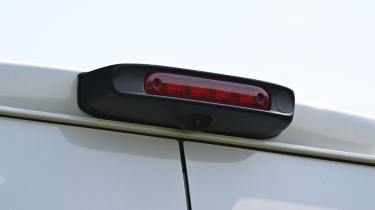
As well as having rear parking sensors as standard, you can add a reversing camera for £200. This adds a camera above the back doors, giving a bird’s eye view of the rear that’s very useful in tight spots. Front parking sensors are available as an option, too.
The Citroen Relay and its parts-sharing cohorts from Peugeot, Vauxhall and Fiat have been in production for a while, so any issues should be well known and reliability should be strong. The diesel engines have been around for a while, while the electric technology is being constantly developed, and with fewer moving parts there should be less to go wrong anyway.
The Relay comes with a three-year/100,000-mile warranty, whether you choose diesel or electric, while the e-Relay’s battery is covered for eight years and up to 70 per cent capacity.
The Relay’s remote central locking system can either open the cab or load bay, while deadlocks and an alarm are fitted.
Driving and performance
Pros |
Cons |
|
|
The downside to the Citroen Relay being such a long-lived machine is that it’s not the most refined large van to drive. Rivals are far better at isolating bumps and delivering comfort, especially at higher speeds. The driving position can feel compromised for some, because the seat feels as if it’s been pushed forward to make as much room as possible for cargo behind.
Visibility is good on the whole, with a few A-pillar blind spots being the biggest issue – the large mirrors take up a lot of room, but the upside of this is a good view along the sides and towards the rear of the van. There’s electric adjustment for the upper mirrors, too, while the lower parts can be adjusted electrically by fitting an option.
The large-capacity 2.2-litre diesel is pretty gruff, and a lack of sound deadening means it can be intrusive into the cabin. It features stop-start, but this causes the whole van to shake when it fires up, and when being extended it sends vibrations through the van body. Still, it has decent performance, considering the van’s size, and we’d recommend the eight-speed automatic gearbox, which makes the most of the diesel’s power with smooth, quick shifts - the manual is a little vague in its operation in comparison.
The e-Relay’s electric motor packs 275bhp, and with 410Nm available from the instant you pull away, it means the electric model is surprisingly quick off the mark. Next to no effort is needed to accelerate quickly, simply press the accelerator and away you go.
Town driving, visibility and parking
With such large dimensions, you’ll have to think twice about where you drive the Relay. It won’t fit in most multi-storey car parks, while the van’s width, at more than two metres wide, means you need to take care at width restrictions and other such obstacles. The steering is relatively light, but has a lot of turns from lock to lock, so low speed manoeuvres need extra care. The rear parking sensors are essential to help with this, while we’d recommend adding the bird’s eye rear camera and even front parking sensors if you’re going to be driving the Relay in town regularly.
The electric e-Relay is well suited to urban driving. With no gears to deal with, you just need to concentrate on steering, with the electric motor always on call to add power when you need it. There are steering wheel paddles that allow you to adjust the amount of energy recovery when you lift off the throttle, with three settings to choose from. The strongest isn’t powerful enough for one-pedal driving, but does offer smoother slowing than if you’re using the discs and pads.
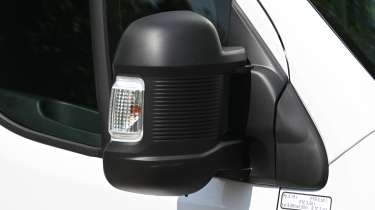
Motorway driving and long-distance comfort
The Relay’s suspension is designed with payloads in mind, and when unladen the van can bounce and pogo over poor surfaces. At higher speeds this is amplified, although the long wheelbase means occupants are only really impacted when the front axle hits a bump.
There’s lots of road noise to go with the gruff engine, while wind noise from the windscreen and mirrors also adds to the cacophony. If you take advantage of the Relay’s substantial payload, then you’ll see a benefit in a smoother ride, but there’s no avoiding the road and wind noise.
For a more refined drive, the electric e-Relay improves things. The weight of the battery located under the cargo floor helps to calm the ride down, so it’s more pleasant in most situations. We’d set the regenerative braking to its lowest level on the motorway to help reduce the amount of lurching when lifting off the throttle.
Cab, interior and technology
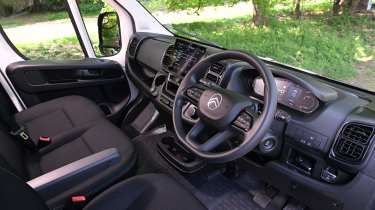
Pros |
Cons |
|
|
There’s a big step up into the Relay’s cab, and when you’re on board there’s plenty of hard plastic around the cabin. That’s fine because it’s designed with function in mind ahead of form, and as a result there is plenty of storage throughout the interior. There’s a big glovebox, a lidded compartment on the passenger side of the dash and numerous shelves, while the large doors have space for two bins and a shelf, too. There’s storage under the twin passenger seat, which is handy for a charging cable in the e-Relay.
One omission is overhead storage in H2 and H3 models. The cab ceiling in these models is at the same height as the H1, because the high roof creates additional storage space in the cargo bay instead.
In terms of space, the wide cabin has plenty of room, with an armrest set between the driver and first passenger, but the driver’s seat is set a little inward from the door, so there’s a bit of a reach to rest your elbow there. Headroom is generous of course, but legroom isn’t necessarily a strong point. If you’re tall, you might find there’s only just enough space to get your legs in without your knees brushing the dashboard.
The cab has been designed with the seats as far forward as possible to maximise cargo space, and this is one of the areas where it’s obvious that compromises have been made. The seat also feels as if it’s tipped forward slightly, making certain driving positions feel a little awkward.

Infotainment, sat-nav and stereo
There’s a six-inch DAB radio screen as standard, or optional seven and 10 inch screens available, the latter as part of a range of Techno Packs. We’ve only tried vans with the latter, and it’s a pretty good system to use. The screen is large and set close, while a row of shortcut buttons across the bottom boost its user-friendliness.
We’d still say it’s best to scroll through the screen when stationary to avoid it distracting, you, but it also comes with a multifunction steering wheel with additional buttons on the back of the spokes that allow you to easily adjust the volume or radio station on the move.
Sat-nav is included with this system, and there are connected services that provide traffic updates. You can bypass the standard system and use Apple CarPlay or Android Auto (either via a cable or wirelessly), and there are USB sockets that allow you to charge your device.
The optional digital dashboard offers plenty of information, although it’s not the clearest layout. There’s a big speedo and plenty of other information contained within it, though.
Citroen’s Free2Move data plan adds wifi to the Relay. This helps with business logistics and to manage vans in real time, offering insights into a vehicle’s status, and whether a service or roadside assistance might be needed when an issue is highlighted.
Buying and owning
Most buyers are going to gravitate towards the diesel models for their mix of low upfront costs and running costs. The electric e-Relay will be a solid alternative for buyers doing short trips around town with easy access to charging. The eight-speed automatic gearbox is well worth considering on the diesel models particularly if you do a lot of your driving in traffic.
Alternatives
The obvious rivals to the Citroen Relay are the platform-sharing alternatives, because there’s very little to choose between them. These comprise the Peugeot Boxer, Vauxhall Movano and Fiat Ducato, while the Toyota Proace Max is a badge-engineered variant. The first four are offered with similar specs and in matching sizes and variants. While the Toyota has a narrower range, but has the added attraction of being covered by a warranty that lasts up to 10 years if you get it serviced annually at a Toyota franchise.��
Beyond these options, the Volkswagen Crafter and MAN TGE are two vans that are built on the same production line and offer a far more refined and upmarket feel than the Citroen. Neither model is offered in as many guises as the Relay, and prices are higher, but you can see a distinct step up in quality when compared with the Relay.
The Mercedes Sprinter is another van that delivers better quality than the Stellantis models, although it’s not that much more refined in diesel guise. The electric e-Sprinter doesn’t offer as long a range as the e-Relay, though.
One model that does offer a good combination of range, refinement and quality is the Ford Transit. The big Ford offers plenty of versatility, while the electric e-Transit is a strong performer with some clever tech on board to help with work life.
However, our current favourite in the large van class is the Renault Master. The latest model features a range of strong and refined engines, while the electric model has a long range and excellent refinement. There aren’t quite as many variants available, but this is made up for with a better driving experience and competitive running costs.
Citroen Relay pictures
Van dimensions
| |||
| Body style | Height | Width | Length |
| Relay L2H1 | 2,254mm | 2,050mm | 5,413mm |
| Relay L2H2 | 2,522mm | 2,050mm | 5,413mm |
| Relay L3H2 | 2,522mm | 2,050mm | 5,998mm |
| Relay L3H3 | 2,760mm | 2,050mm | 5,998mm |
| Relay L4H2 | 2,522mm | 2,050mm | 6,363mm |
| Relay L4H3 | 2,760mm | 2,050mm | 6,363mm |
Load area dimensions | ||||
| Body style | Height | Width | Length | Volume |
| Relay L2H1 | 1,662mm | 1,870mm | 3,120mm | 10m3 |
| Relay L2H2 | 1,932mm | 1,870mm | 3,120mm | 11.5m3 |
| Relay L3H2 | 1,932mm | 1,870mm | 3,705mm | 13m3 |
| Relay L3H3 | 2,172mm | 1,870mm | 3,705mm | 15m3 |
| Relay L4H2 | 1,932mm | 1,870mm | 4,070mm | 15m3 |
| Relay L4H3 | 2,172mm | 1,870mm | 4,070mm | 17m3 |
Frequently Asked Questions
For the sheer variety offered, the Relay should have a variant to suit everybody. It’s not the most refined or comfortable van to drive (especially in diesel guise), but it gets the job done.


